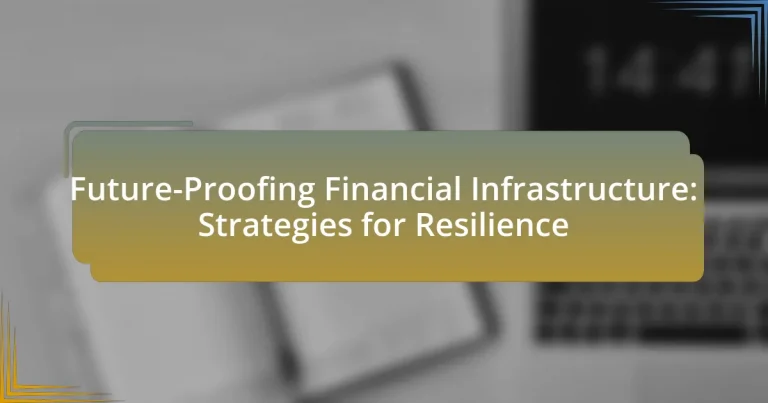Future-proofing financial infrastructure involves designing adaptable systems that can respond to technological, regulatory, and market changes. This article outlines strategies for enhancing resilience, including the integration of scalable technologies, compliance with regulations, and robust cybersecurity measures. It discusses the assessment of current financial infrastructure through audits and key performance indicators, the impact of regulatory requirements, and the importance of resilience in maintaining operational continuity. Additionally, it highlights the role of emerging technologies, best practices for financial resilience, and practical steps organizations can take to strengthen their infrastructure against future challenges.

What does Future-Proofing Financial Infrastructure entail?
Future-proofing financial infrastructure entails designing and implementing systems that can adapt to evolving technological, regulatory, and market conditions. This approach includes integrating scalable technologies, ensuring compliance with emerging regulations, and enhancing cybersecurity measures to protect against threats. For instance, the adoption of cloud computing and blockchain technology allows for greater flexibility and efficiency, while regular updates to security protocols safeguard sensitive financial data. These strategies collectively ensure that financial institutions remain resilient and competitive in a rapidly changing landscape.
How can organizations assess their current financial infrastructure?
Organizations can assess their current financial infrastructure by conducting a comprehensive audit of their financial systems, processes, and technologies. This audit should include evaluating the efficiency of financial reporting, the effectiveness of internal controls, and the integration of financial software with other business systems. For instance, a study by Deloitte highlights that organizations that regularly assess their financial infrastructure can identify inefficiencies and compliance risks, leading to improved financial performance and strategic decision-making. Additionally, benchmarking against industry standards can provide insights into areas for improvement, ensuring that the financial infrastructure remains resilient and adaptable to future challenges.
What key indicators should be evaluated in a financial infrastructure assessment?
Key indicators to evaluate in a financial infrastructure assessment include system reliability, transaction speed, security measures, regulatory compliance, and user accessibility. System reliability assesses the uptime and performance of financial systems, which is critical for uninterrupted service. Transaction speed measures the efficiency of processing transactions, impacting customer satisfaction and operational effectiveness. Security measures evaluate the robustness of protections against fraud and cyber threats, essential for maintaining trust. Regulatory compliance ensures adherence to financial laws and standards, which is vital for legal operation. User accessibility examines how easily clients can access services, influencing overall engagement and satisfaction. These indicators collectively provide a comprehensive view of the financial infrastructure’s effectiveness and resilience.
How do regulatory requirements impact financial infrastructure assessments?
Regulatory requirements significantly impact financial infrastructure assessments by establishing standards that ensure stability, transparency, and risk management within financial systems. These regulations, such as the Basel III framework, mandate capital adequacy, stress testing, and liquidity requirements, which directly influence how financial institutions evaluate their infrastructure capabilities. Compliance with these regulations necessitates rigorous assessments of operational resilience, technological robustness, and risk exposure, thereby shaping the overall infrastructure strategy. For instance, the implementation of the Dodd-Frank Act in the United States has led to enhanced scrutiny of financial institutions, compelling them to adopt more comprehensive risk assessment frameworks to meet regulatory expectations.
Why is resilience important in financial infrastructure?
Resilience is crucial in financial infrastructure because it ensures the system can withstand and recover from disruptions, such as economic crises or cyberattacks. A resilient financial infrastructure minimizes the risk of systemic failures, which can lead to widespread economic instability. For instance, during the 2008 financial crisis, institutions with robust risk management frameworks were better able to navigate the turmoil, highlighting the importance of resilience in maintaining operational continuity and public confidence in the financial system.
What are the potential risks associated with inadequate financial infrastructure?
Inadequate financial infrastructure poses significant risks, including increased transaction costs, reduced access to financial services, and heightened vulnerability to fraud and cyberattacks. These risks stem from a lack of efficient payment systems and regulatory frameworks, which can lead to inefficiencies in capital allocation and hinder economic growth. For instance, according to the World Bank, countries with underdeveloped financial systems experience slower GDP growth rates, as they struggle to mobilize savings and facilitate investments effectively. Additionally, inadequate infrastructure can result in financial exclusion, where marginalized populations are unable to access essential banking services, further exacerbating inequality.
How does resilience contribute to long-term sustainability in finance?
Resilience contributes to long-term sustainability in finance by enabling financial systems to withstand and recover from economic shocks and disruptions. This capacity for recovery ensures that financial institutions can maintain operations, protect assets, and continue to provide services during crises, thereby fostering stability in the broader economy. For instance, during the 2008 financial crisis, resilient banks that had robust risk management practices were able to navigate the downturn more effectively, leading to quicker recovery and less systemic impact. Additionally, research from the World Economic Forum highlights that resilient financial systems are better equipped to adapt to changing market conditions, which is essential for sustainable growth in an increasingly volatile environment.

What strategies can be employed for future-proofing financial infrastructure?
To future-proof financial infrastructure, organizations should adopt strategies such as embracing digital transformation, enhancing cybersecurity measures, and implementing regulatory compliance frameworks. Digital transformation enables financial institutions to leverage advanced technologies like blockchain and artificial intelligence, which improve efficiency and customer experience. Enhanced cybersecurity measures are critical, as the financial sector faces increasing threats; for instance, a report by Cybersecurity Ventures predicts that cybercrime will cost the world $10.5 trillion annually by 2025, highlighting the need for robust defenses. Regulatory compliance frameworks ensure that financial institutions adapt to evolving regulations, thereby mitigating risks associated with non-compliance and fostering trust among stakeholders.
How can technology enhance financial infrastructure resilience?
Technology enhances financial infrastructure resilience by enabling real-time data analytics, improving cybersecurity measures, and facilitating automated recovery processes. Real-time data analytics allows financial institutions to monitor transactions and detect anomalies swiftly, reducing the risk of fraud and operational disruptions. For instance, the implementation of machine learning algorithms can analyze vast datasets to identify patterns indicative of potential threats, thereby enhancing proactive risk management.
Moreover, advanced cybersecurity technologies, such as blockchain and encryption, protect sensitive financial data from breaches, ensuring the integrity and availability of financial services. According to a report by the World Economic Forum, organizations that adopt robust cybersecurity frameworks can reduce the likelihood of significant financial losses from cyber incidents by up to 50%.
Finally, technology supports automated recovery processes through cloud computing and disaster recovery solutions, which ensure that financial systems can quickly restore operations after disruptions. A study by IBM found that organizations with automated recovery capabilities can reduce downtime by 80%, significantly enhancing overall resilience.
What role do emerging technologies play in financial infrastructure?
Emerging technologies play a crucial role in enhancing the efficiency, security, and accessibility of financial infrastructure. These technologies, such as blockchain, artificial intelligence, and cloud computing, streamline processes, reduce operational costs, and improve transaction speeds. For instance, blockchain technology enables secure and transparent transactions, minimizing fraud and enhancing trust among stakeholders. According to a report by the World Economic Forum, the adoption of blockchain in financial services could save banks up to $20 billion annually by 2022 through reduced transaction costs and improved efficiency. Additionally, artificial intelligence enhances risk management and customer service, allowing financial institutions to analyze vast amounts of data for better decision-making. Overall, the integration of these emerging technologies is essential for building a resilient financial infrastructure capable of adapting to future challenges.
How can organizations integrate technology into their existing systems?
Organizations can integrate technology into their existing systems by adopting a phased approach that includes assessing current infrastructure, identifying gaps, and implementing compatible solutions. This process often begins with a thorough evaluation of existing systems to determine their capabilities and limitations, which allows organizations to pinpoint specific areas where technology can enhance efficiency and effectiveness. For instance, a study by McKinsey & Company highlights that organizations that leverage cloud computing can improve operational agility by up to 30%, demonstrating the tangible benefits of integrating modern technology. Following the assessment, organizations should prioritize technology solutions that align with their strategic goals and ensure interoperability with existing systems, thereby minimizing disruption and maximizing return on investment.
What best practices should organizations adopt for financial resilience?
Organizations should adopt diversified revenue streams, robust cash flow management, and strategic cost control as best practices for financial resilience. Diversifying revenue streams mitigates risks associated with market fluctuations, as evidenced by companies that successfully navigated economic downturns by having multiple income sources. Effective cash flow management ensures that organizations maintain liquidity, allowing them to meet obligations even during challenging periods; research indicates that businesses with strong cash flow practices are 30% more likely to survive financial crises. Additionally, implementing strategic cost control measures helps organizations optimize expenses without sacrificing quality, which is crucial for maintaining profitability in uncertain environments.
How can risk management frameworks be implemented effectively?
Risk management frameworks can be implemented effectively by establishing a structured process that includes risk identification, assessment, response planning, and monitoring. Organizations should begin by identifying potential risks through comprehensive analysis and stakeholder engagement, ensuring that all relevant risks are considered. Following identification, a thorough assessment should be conducted to evaluate the likelihood and impact of each risk, allowing for prioritization based on severity.
Next, organizations must develop response plans that outline specific actions to mitigate identified risks, which may include risk avoidance, reduction, sharing, or acceptance. Continuous monitoring and review of the risk management framework are essential to adapt to changing circumstances and emerging risks, ensuring that the framework remains relevant and effective.
Evidence of effective implementation can be seen in organizations that adopt industry standards such as ISO 31000, which provides guidelines for risk management processes, leading to improved decision-making and enhanced resilience against financial disruptions.
What are the benefits of continuous training and development for staff?
Continuous training and development for staff enhances employee skills, increases job satisfaction, and improves organizational performance. By regularly updating skills, employees remain competitive and adaptable to industry changes, which is crucial in a rapidly evolving financial landscape. Research indicates that companies investing in employee development experience 24% higher profit margins and 218% higher income per employee, demonstrating a direct correlation between training and financial success. Furthermore, continuous learning fosters a culture of innovation, leading to improved problem-solving and efficiency within teams.

How can organizations measure the effectiveness of their future-proofing strategies?
Organizations can measure the effectiveness of their future-proofing strategies by utilizing key performance indicators (KPIs) that assess adaptability, risk management, and financial stability. These KPIs may include metrics such as revenue growth in changing markets, customer retention rates during economic shifts, and the speed of response to regulatory changes. For instance, a study by McKinsey & Company found that organizations with robust risk management frameworks experienced 20% higher revenue growth during economic downturns compared to those without such frameworks. This demonstrates that effective future-proofing strategies can be quantitatively assessed through specific, measurable outcomes that reflect an organization’s resilience and adaptability in the face of change.
What metrics are essential for evaluating financial infrastructure resilience?
Essential metrics for evaluating financial infrastructure resilience include operational uptime, recovery time objective (RTO), recovery point objective (RPO), and stress testing results. Operational uptime measures the percentage of time the financial system is fully operational, indicating reliability. RTO defines the maximum acceptable time to restore services after a disruption, while RPO specifies the maximum acceptable data loss measured in time. Stress testing results assess the system’s ability to withstand extreme conditions, providing insights into vulnerabilities. These metrics collectively offer a comprehensive view of resilience, ensuring that financial infrastructures can effectively respond to and recover from adverse events.
How can organizations track improvements over time?
Organizations can track improvements over time by implementing key performance indicators (KPIs) that measure specific outcomes related to their goals. By regularly collecting and analyzing data on these KPIs, organizations can assess progress and identify areas for further enhancement. For instance, a study by the Harvard Business Review found that organizations using data-driven decision-making improved their productivity by 5-6%. This evidence supports the effectiveness of systematic tracking in fostering continuous improvement and resilience in financial infrastructure.
What tools can assist in measuring financial infrastructure performance?
Tools that can assist in measuring financial infrastructure performance include performance analytics software, benchmarking tools, and risk assessment frameworks. Performance analytics software, such as Tableau or Power BI, enables organizations to visualize and analyze financial data, providing insights into operational efficiency and effectiveness. Benchmarking tools, like the Global Financial Stability Report, allow institutions to compare their performance against industry standards and peers, identifying areas for improvement. Risk assessment frameworks, such as the Basel III guidelines, help in evaluating the resilience of financial systems by assessing capital adequacy, liquidity, and risk management practices. These tools collectively provide a comprehensive approach to measuring and enhancing financial infrastructure performance.
What common challenges do organizations face in future-proofing their financial infrastructure?
Organizations commonly face challenges such as technological obsolescence, regulatory compliance, and integration of legacy systems when future-proofing their financial infrastructure. Technological obsolescence occurs as rapid advancements in technology can render existing systems outdated, necessitating continuous investment in upgrades. Regulatory compliance poses a challenge as organizations must adapt to evolving financial regulations, which can vary significantly across jurisdictions. Additionally, integrating legacy systems with new technologies often leads to compatibility issues, increasing operational complexity and costs. These challenges highlight the need for strategic planning and investment in adaptable, scalable financial solutions.
How can organizations overcome resistance to change within their teams?
Organizations can overcome resistance to change within their teams by fostering open communication and involving team members in the change process. Engaging employees in discussions about the reasons for change and soliciting their input can increase buy-in and reduce apprehension. Research indicates that organizations that prioritize transparent communication during transitions experience a 70% success rate in change initiatives, as highlighted in a study by Kotter International. By addressing concerns and providing support, organizations can create a culture that embraces change rather than resists it.
What strategies can mitigate the costs associated with upgrading infrastructure?
Implementing phased upgrades is a key strategy to mitigate the costs associated with upgrading infrastructure. By breaking down the upgrade process into smaller, manageable phases, organizations can spread out expenses over time, allowing for better budget management and reduced financial strain. Additionally, leveraging public-private partnerships can provide access to additional funding sources and expertise, further alleviating costs. For instance, a study by the American Society of Civil Engineers highlights that such collaborations can lead to cost savings of up to 30% in infrastructure projects. Furthermore, utilizing technology such as predictive analytics can optimize resource allocation and maintenance schedules, ultimately reducing long-term operational costs.
What practical steps can organizations take to enhance their financial infrastructure resilience?
Organizations can enhance their financial infrastructure resilience by implementing robust risk management frameworks. These frameworks should include regular stress testing to evaluate the impact of various economic scenarios on financial stability, as evidenced by the Basel III guidelines which emphasize the importance of capital adequacy and liquidity management. Additionally, organizations should invest in advanced technology solutions, such as blockchain and artificial intelligence, to improve transaction security and operational efficiency. According to a report by McKinsey, firms that adopt digital tools can reduce operational risks by up to 30%. Furthermore, establishing strong partnerships with regulatory bodies and industry peers can facilitate knowledge sharing and best practices, thereby strengthening overall resilience.


